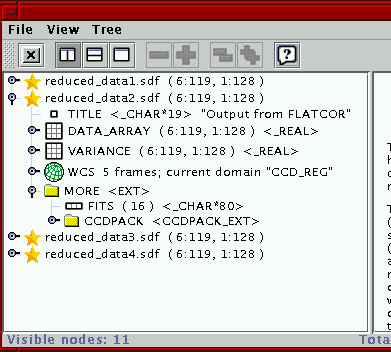



Next: Popup menu
Up: The Treeview window
Previous: The Treeview window
The main area to the left of the window displays the tree with the
data nodes in it. Each node is shown on a single line,
and is represented by an icon,
followed by its name, followed by some brief descriptive information.
Additionally, there may be a handle
like this  at the left of the line
if this node can be opened up to see inside.
In the example shown in the previous section,
each icon is a little star, indicating that the nodes
have been recognised as NDF structures, the names are as given,
and the descriptive information gives the pixel bounds of the NDFs.
These nodes do have handles, since Treeview knows how to understand
the data inside them.
The different types of nodes which Treeview knows about are listed
in section
at the left of the line
if this node can be opened up to see inside.
In the example shown in the previous section,
each icon is a little star, indicating that the nodes
have been recognised as NDF structures, the names are as given,
and the descriptive information gives the pixel bounds of the NDFs.
These nodes do have handles, since Treeview knows how to understand
the data inside them.
The different types of nodes which Treeview knows about are listed
in section ![[*]](cross_ref_motif.gif) .
.
Nodes with handles can be opened up to display their children.
The easiest way to do this is to click on the handle itself with
the mouse, though various other actions will do the trick,
including double-clicking on the name, and if the node is
selected (see ![[*]](cross_ref_motif.gif) ) pressing the return key or clicking
the
) pressing the return key or clicking
the  icon in the toolbar. Once opened, they can be
closed in a similar way. The child nodes behave like their
parents, and can be opened and closed in the same fashion.
When a node is open the handle is rotated to look like this
icon in the toolbar. Once opened, they can be
closed in a similar way. The child nodes behave like their
parents, and can be opened and closed in the same fashion.
When a node is open the handle is rotated to look like this
 .
Here is a what the window looks like when a couple of the nodes
have been opened:
.
Here is a what the window looks like when a couple of the nodes
have been opened:





Next: Popup menu
Up: The Treeview window
Previous: The Treeview window
TREEVIEW - Hierarchical data viewer
Starlink User Note 244
Mark Taylor
30 October 2001
E-mail:ussc@star.rl.ac.uk
Copyright © 2001 Council for the Central Laboratory of the Research Councils
 at the left of the line
if this node can be opened up to see inside.
In the example shown in the previous section,
each icon is a little star, indicating that the nodes
have been recognised as NDF structures, the names are as given,
and the descriptive information gives the pixel bounds of the NDFs.
These nodes do have handles, since Treeview knows how to understand
the data inside them.
The different types of nodes which Treeview knows about are listed
in section
at the left of the line
if this node can be opened up to see inside.
In the example shown in the previous section,
each icon is a little star, indicating that the nodes
have been recognised as NDF structures, the names are as given,
and the descriptive information gives the pixel bounds of the NDFs.
These nodes do have handles, since Treeview knows how to understand
the data inside them.
The different types of nodes which Treeview knows about are listed
in section ![[*]](cross_ref_motif.gif) .
.

 icon in the toolbar. Once opened, they can be
closed in a similar way. The child nodes behave like their
parents, and can be opened and closed in the same fashion.
When a node is open the handle is rotated to look like this
icon in the toolbar. Once opened, they can be
closed in a similar way. The child nodes behave like their
parents, and can be opened and closed in the same fashion.
When a node is open the handle is rotated to look like this
 .
Here is a what the window looks like when a couple of the nodes
have been opened:
.
Here is a what the window looks like when a couple of the nodes
have been opened:
